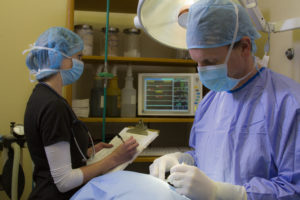
Anesthesia
 With advancements in veterinary methods and technology, surgery has become an increasingly successful course of action in pet wellbeing.
With advancements in veterinary methods and technology, surgery has become an increasingly successful course of action in pet wellbeing.
Anesthesia Anxiety
Yet, when a surgical procedure is recommended the Number One question pet owners ask is about the safety and effects of anesthesia on pets. Frequently, concern about the operation itself pales in comparison to concern about the use of anesthesia and potential risk factors, such as age.
So, it’s important to understand all the meticulous protocols that go into surgical prep, procedure and post-operative recovery.
 It starts with comprehensive pre-operative blood work that measures red and white blood cells and includes a blood chemistry screen. Given pet health history, further tests may be conducted in order to confirm readiness for the proposed surgical procedure.
It starts with comprehensive pre-operative blood work that measures red and white blood cells and includes a blood chemistry screen. Given pet health history, further tests may be conducted in order to confirm readiness for the proposed surgical procedure.
In preparation for the operation, an IV catheter is placed to deliver fluids to keep the patient hydrated during the procedure, while also allowing for quick access should additional medications during surgery be needed.
Then, a sedative injection is followed by placement of an endo-tracheal tube that facilitates the flow of Sevoflurane Anesthesia and oxygen. We choose Sevoflurane Anesthesia because it allows for the patient to easily slip out of and back into consciousness, reducing stress on the body as it responds to the delivery flow of the anesthesia.
Special Steps During Surgery

During surgery, our pet patients are placed on a heated table with the addition of a “Bear Hugger” warm air wrap when it does not hamper access to the surgical location.
Because we understand the importance of vigilance during any surgical procedure, electronic monitoring of vital signs is supplemented with regular readings recorded by a member of our surgical team.
An EKG and Pulse Oximeter that measures oxygen percentage help facilitate those readings.
 Recovery Vigilance
Recovery Vigilance
Once surgery is completed, our pet patients recover in an area where they can be closely observed as they ease out of the anesthesia and show gradual signs of responsiveness.
Careful monitoring matters!
 So, when considering a recommended surgical option, it’s important to consider not only the skill of the vet surgeon, but also the manner with which pet patients are treated before, during and after surgery.
So, when considering a recommended surgical option, it’s important to consider not only the skill of the vet surgeon, but also the manner with which pet patients are treated before, during and after surgery.
Knowing this will help allay owner anxiety about anesthesia!





